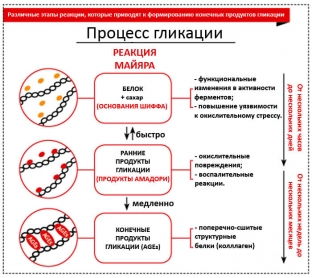Aging – it is a multifactorial process involving genetic, endogenous and environmental factors. As skin ages, it loses moisture, thins, and photodamage becomes more pronounced. Such consequences are the result of genetic and epigenetic factors. There are two main levels of skin aging – internal (chronological aging, which is individual and depends on genetic characteristics) and external (occurs under the influence of environmental factors such as ultraviolet radiation, pollutants, etc.). One of the external factors associated with premature aging is the accumulation of advanced glycation end products (AGEs).
 Jana Janovska (Jana Janovska), Dermatovenerologist, Dermaclinica, Riga, Latvia
Jana Janovska (Jana Janovska), Dermatovenerologist, Dermaclinica, Riga, Latvia
Lana Kasparane (Lana Kasparane), Julia Wojciechowska (Julia Voicehovska), Sergey Babikovs and Jānis Ķīsis talk about the results of their research aimed at studying the effect of glycation end products on skin aging.
Role of glycation end products in altering skin biological processes
There are two main differences between the biochemical processes of glycosylation and glycation. Glycolysis – this is a process that occurs with the participation of enzymes, and glycation – slow non-enzymatic reaction between the amino groups of proteins (mainly lysine) and reducing sugars.
Glycation occurs when glucose (the main source of energy) binds to deoxyribonucleic acid (DNA), proteins and fats, causing their function to be impaired. As a result of this reaction, remnants of glycation end products (AGEs) appear in the extracellular matrix of the dermis; however, some of them have characteristic fluorescent properties, which the authors determined using a special device called AGE reader™ (manufactured by Diagnoptics Technologies BV, the Netherlands). In this case, glycation proceeds by the Maillard reaction, which consists in the binding of electrophilic carbonyl groups or sugars with lysine or arginine (amino acids).

The level of advanced glycation end products in mature skin (not in the blood) is a marker of glycometabolic and oxidative stress.
The end products of glycation lead to biological changes that affect the activation of the synthesis of molecules. AGEs generation supported:
- ultraviolet radiation;
- oxygen;
- reactive oxygen species (ROS);
- redox active transition metals.
AGEs receptors activate various molecular pathways, thus participating in:
- inflammation;
- immune response;
- cell proliferation;
- gene expression.
Exposure of ultraviolet A radiation to glycation end products leads to the formation of reactive oxygen species such as radicals:
- superoxide anion;
- hydrogen peroxide radical;
- hydroxyl radical.
These free radicals may stimulate the production of superoxide anion by NADP oxidase or weaken the antioxidant defense system.
Skin, metabolic syndrome and advanced glycation end products
The main characteristics of the metabolic syndrome are:
- central obesity;
- impaired glucose tolerance;
- dyslipidemia;
- arterial hypertension.
About a third of the world's population suffers from this disease.
Various dermatological diseases are associated with the metabolic syndrome and/or its components. Also, the metabolic syndrome partially accelerates the aging process.
Due to the influence of the metabolic syndrome on the body, including the skin, there are signs of sluggish inflammation caused by oxidative stress – a condition in which reactive oxygen species exceed the body's antioxidant capacity, resulting in the release of inflammatory cytokines and a persistent inflammatory defense response in the skin.
An excess of reactive oxygen species leads to lipid peroxidation, oxidative damage to proteins and DNA, and oxidative stress negatively affects collagen biosynthesis and exacerbates inflammation, leading to:
- activation of matrix metalloproteniasis;
- activation of aryl hydrocarbon receptors (AhR);
- reactive oxygen species and redox activate transition metals, resulting in accelerated formation of advanced glycation end products.
As a result of glycation and the accumulation of advanced glycation end products in the skin, pro-inflammatory processes are activated, premature apoptosis (cell death), oxidative damage is exacerbated, and even precancerous skin diseases such as actinic keratosis develop.
On a microscopic level, such changes are expressed in:
- appearance of small wrinkles;
- loss of elasticity;
- thinning of the epidermis and dermis;
- decrease in the rate of mitosis of basal keranocytes;
- decrease in proliferative capacity;
- cellular aging.
The loss of skin elasticity is caused by the formation of bridges between the molecular constituents of the dermis and AGEs. Glycation end products lead to disturbances in the extracellular matrix due to the fact that:
- AGEs provoke biological changes in the synthesis of molecules;
- activation of an enzyme that leads to the destruction of the matrix (metal proteniasis);
- UV exposure to glycation end products in the extracellular matrix leads to the formation of reactive oxygen species, which leads to irreversible changes in the dermis.
Foods with a high glycemic index contribute to the accumulation of end products of glycation in the body, which not only accelerates the aging process, but is also a serious factor in the development of chronic diseases, especially diabetes, cardiovascular diseases and even cancer. Therefore, it is important to limit your carbohydrate intake and opt for low glycemic foods such as apples, cashews, oranges, and brown rice.
Despite the fact that the main functions of the skin are well known, its role in systemic metabolic disorders is not fully understood. Therefore, further research is needed to improve understanding of the early manifestations of the metabolic syndrome in the skin, as well as its impact on the biological and aesthetic function of the skin.
According to Prime magazine.







Add a comment